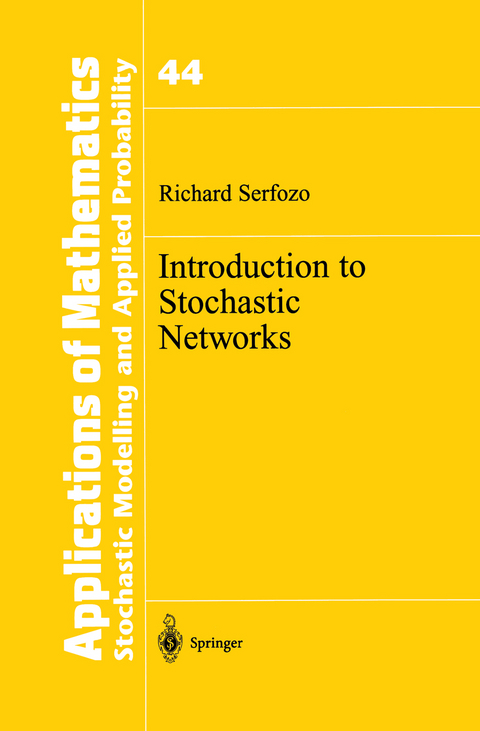
Introduction to Stochastic Networks
Springer-Verlag New York Inc.
978-0-387-98773-6 (ISBN)
1 Jackson and Whittle Networks.- 1.1 Preliminaries on Networks and Markov Processes.- 1.2 Tandem Network.- 1.3 Definitions of Jackson and Whittle Processes.- 1.4 Properties of Service and Routing Rates.- 1.5 Equilibrium behavior.- 1.6 Production-Maintenance Network.- 1.7 Networks with Special Structures.- 1.8 Properties of Jackson Equilibrium Distributions.- 1.9 Convolutions for Single-Server Nodes.- 1.10 Throughputs and Expected Sojourn Times.- 1.11 Algorithms for Performance Parameters.- 1.12 Monte Carlo Estimation of Network Parameters.- 1.13 Properties of Whittle Networks.- 1.14 Exercises.- 1.15 Bibliographical Notes.- 2 Reversible Processes.- 2.1 Reversibility.- 2.2 Time Reversal.- 2.3 Invariant Measures.- 2.4 Construction of Reversible Processes.- 2.5 More Birth-Death Processes.- 2.6 Reversible Network Processes.- 2.7 Examples of Reversible Networks.- 2.8 Partition-Reversible Processes.- 2.9 Examples of Partition-Reversible Processes.- 2.10 Exercises.- 2.11 Bibliographical Notes.- 3 Miscellaneous Networks.- 3.1 Networks with Multiple Types of Units.- 3.2 Kelly Networks: Route-dependent Services.- 3.3 BCMP Networks: Class-Node Service Dependencies.- 3.4 Networks with Cox and General Service Times.- 3.5 Networks with Constraints.- 3.6 Networks with Blocking and Rerouting.- 3.7 Bottlenecks in Closed Jackson Networks.- 3.8 Modeling Whittle Networks by Locations of the Units.- 3.9 Partially Balanced Networks.- 3.10 Exercises.- 3.11 Bibliographical Notes.- 4 Network Flows and Travel Times.- 4.1 Point Process Notation.- 4.2 Extended Lévy Formula for Markov Processes.- 4.3 Poisson Functionals of Markov Processes.- 4.4 Multivariate Compound Poisson Processes.- 4.5 Poisson Flows in Jackson and Whittle Networks.- 4.6 Palm Probabilities for Markov Processes.- 4.7 Sojourn andTravel Times of Markov Processes.- 4.8 Palm Probabilities of Jackson and Whittle Networks.- 4.9 Travel Times on Overtake-Free Routes.- 4.10 Exercises.- 4.11 Bibliographical Notes.- 5 Little Laws.- 5.1 Little Laws for Markovian Systems.- 5.2 Little Laws for General Queueing Systems.- 5.3 Preliminary Laws of Large Numbers.- 5.4 Utility Processes.- 5.5 Omnibus Little Laws.- 5.6 Little Laws for Regenerative Systems.- 5.7 Exercises.- 5.8 Bibliographical Notes.- 6 Stationary Systems.- 6.1 Preliminaries on Stationary Processes.- 6.2 Palm Probabilities.- 6.3 Campbell-Mecke Formulas for Palm Probabilities.- 6.4 Little Laws for Stationary Systems.- 6.5 Sojourn Times and Related Functionals.- 6.6 Travel Times for Stochastic Processes.- 6.7 Sojourn and Travel Times in Networks.- 6.8 Exercises.- 6.9 Bibliographical Notes.- 7 Networks with String Transitions.- 7.1 Definition of a String-Net.- 7.2 Invariant Measures of String-Nets.- 7.3 Traffic Equations, Partial Balance, and Throughputs.- 7.4 String-Nets with Unit-Vector Transitions.- 7.5 Networks with One-Stage Batch Transitions.- 7.6 Networks with Compound-Rate String Transitions.- 7.7 Networks with Multiple, Compound-Rate String Transitions.- 7.8 String-Nets with Two-Node Batch Transitions.- 7.9 Single Service Station With String Transitions.- 7.10 Bibliographical Notes.- 8 Quasi-Reversible Networks and Product Form Distributions.- 8.1 Quasi-Reversibility.- 8.2 Network to be Studied.- 8.3 Characterization of Product Form Distributions.- 8.4 Quasi-Reversibility and Biased Local Balance.- 8.5 Networks with Reversible Routing.- 8.6 Queueing Networks.- 8.7 Time-Reversals and Departure—Arrival Reversals.- 8.8 Networks with Multiclass Transitions.- 8.9 Exercises.- 8.10 Bibliographical Notes.- 9 Space—Time Poisson Models.- 9.1Introductory Examples.- 9.2 Laplace Functionals of Point Processes.- 9.3 Transformations of Poisson Processes.- 9.4 Translations, Partitions, and Clusters.- 9.5 Service Systems with No Queueing.- 9.6 Network of M/G/? Service Stations.- 9.7 Particle Systems.- 9.8 Poisson Convergence of Space-Time Processes.- 9.9 Transformations into Large Spaces.- 9.10 Particle Flows in Large Spaces.- 9.11 Exercises.- 9.12 Bibliographical Notes.- 10 Spatial Queueing Systems.- 10.1 Preliminaries.- 10.2 Stationary Distributions and Ergodicity.- 10.3 Properties of Stationary Distributions and Examples.- 10.4 Throughputs and Expected Sojourn Times.- 10.5 Poisson Flows in Open Systems.- 10.6 Systems with Multiclass Units.- 10.7 Bibliographical Notes.- References.
| Reihe/Serie | Stochastic Modelling and Applied Probability ; 44 |
|---|---|
| Zusatzinfo | XIV, 301 p. |
| Verlagsort | New York, NY |
| Sprache | englisch |
| Maße | 155 x 235 mm |
| Themenwelt | Mathematik / Informatik ► Mathematik ► Wahrscheinlichkeit / Kombinatorik |
| ISBN-10 | 0-387-98773-8 / 0387987738 |
| ISBN-13 | 978-0-387-98773-6 / 9780387987736 |
| Zustand | Neuware |
| Haben Sie eine Frage zum Produkt? |
aus dem Bereich


